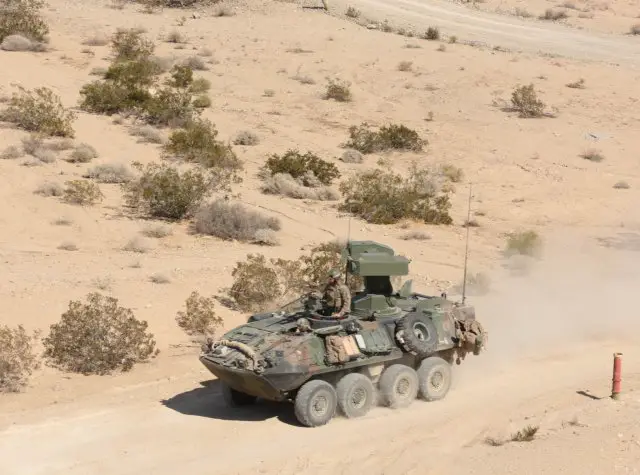The US Marine Corps starts testing Light-Armored Vehicle fitted with Anti-Tank Weapon System
|
|
|||||
|
Military Defense Industry Technology - USMC tests LAV ATWS
|
|||||
|
|
|||||
| The US Marine Corps starts testing Light-Armored Vehicle fitted with Anti-Tank Weapon System | |||||
|
The United States Marine Corps Operational Test Evaluation Activity section began operational testing of the Light-Armored Vehicle Anti-Tank Weapons System aboard the Combat Center and is scheduled to continue until March 8, 2015.
|
|||||
 USMC began operational testing of the Light-Armored Vehicle Anti-Tank Weapon System USMC began operational testing of the Light-Armored Vehicle Anti-Tank Weapon System(Credit: USMC) |
|||||
|
The demonstration spotlighted the versatility of the system, which can carry communications equipment, as well as Mobile Electronic Warfare Support Systems, providing a self-contained and highly mobile combined arms force. An LAV detachment conducts security, reconnaissance and screening operations for a larger force, as well as limited independent operations on its own.
The LAV-ATWS is a Marine Corps Systems Command program, which addresses issues of the legacy Emerson 901 turret by replacing the turret system with a modern launcher. The Program Manager, Col Mark T. Brinkman, is confident that the system provides the Marine Corps with substantial improvements over the previous anti-tank system. “The ATWS concurrently addresses obsolesce and maintenance issues, while keeping the LAV Anti-Tank capability relevant for future conflicts,” Brinkman said. “We have just upgraded the Marine’s capability, making us more efficient, effective and lethal.” The modernized LAV-ATWS will give the Marines additional capabilities to acquire targets, have a far- target capability, and include an advanced thermal sight in addition to an advanced guidance control system. The program is completing the Systems Demonstration phase of the program with an operational test. “We are currently in operational testing, which allows us to see how the system performs in training,” Capt. Zachary Stanley, operational test project officer, LAV-ATWS Modernization program, MCOTEA, said. “We gave it to the Marines and units it’s going to be fielded in for them to operate side-by-side with platoons using the previous model, the Emerson 901. We can compare times and accuracy through these trial runs.” Through the new anti-tank weapons system and optics, the vehicle will be able to engage armored targets on the move while providing another vantage point for commanders on the battlefield. “It gives commanders another set of eyes as opposed to the old system, which has to wait for another vehicle to spot the threat before anti-tank vehicles can respond,” Stanley said. “The gunner is located inside the LAV with a bi-optical screen he constantly looks at to analyze the battlefield and engage targets.” |
|||||
|
|
|||||
 USMC's Light-Armored Vehicle fitted with Anti-Tank Weapon System USMC's Light-Armored Vehicle fitted with Anti-Tank Weapon System(Credit: USMC) |
|||||
|
|
|||||
|
During this stage of testing, LAR Marines got a first-hand look at what the new system will add to the Marine Corps’ arsenal and combat readiness. New capabilities include mobility while firing TOW missiles, allowing for shooting on-the-move, and improved optic magnification for enhanced target acquisition.
“The turret doesn’t have to be stowed for us to move and the optics allow for an enhanced view of the area,” said Cpl. Brandon Jones, vehicle commander, TOW missile section, 3rd LAR. “These new systems and capabilities would make us more of an asset to the LAR community.” When a missile is launched, the computer in the vehicle communicates with it through a wire connected to the turret, as the gunner maintains a set of crosshairs on target. This process allows the Marine to guide the missile until contact is made. “Speaking from experiences I had as a gunner, it can be very disorienting to look at a screen for so long,” Jones said. “The amount of focus needed to keep the crosshairs steady leads to a lot of stress behind the sticks. Although it doesn’t make the job easier, it allows us to operate as an anti-tank crew more effectively.” 3rd LAR has been training alongside 1st Tank Battalion and 1st LAR during the testing of the new anti-tank system. The operational testing has given Marines using the new LAV-ATWS an opportunity to give their input on the system and shape the future of the Marine Corps’ anti-tank light-armored reconnaissance capability. “Our Marines really enjoyed giving input on the system,” said Capt. Charlie Richardson, Company B light-armored vehicle officer, 3rd LAR. “MCOTEA has done a great job of collecting the [feedback] by giving Marines an opportunity to tell what does and does not work. Through these tests, the Marines are making a direct [impact] on the future.” Successful completion of this test will support a decision to begin production of the new Anti-Tank Weapon System for the LAV, with fielding of the system to the operating forces projected for 2017. |
|||||


























